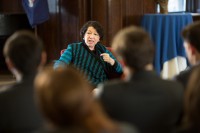Supreme Court Justice Sotomayor Addresses Pace Students in White Plains

Photo courtesy of Pace University
Growing up in the Bronx, Sonya Sotomayor had dreams of becoming a detective.
“I read Nancy Drew and I wanted to be a detective,” Sotomayor said on November 12, during a panel discussion in the Moot courtroom at the Gerber Glass Law Library at Pace University in White Plains
But because she is a diabetic, Sotomayor said being a detective was not possible for her. Instead, she decided to follow the path of another fictional character, Perry Mason, and she became a lawyer.
Sotomayor’s career choice at an early age not only influenced her life, it would ultimately change the course of history in the United States. Sotomayor became the first Hispanic to serve on the U.S. Supreme Court. Sotomayor has been a Supreme Court justice since August 2009.
The motivation for Sotomayor’s law career was one of the topics she spoke about while answering students’ questions.
This was not Sotomayor’s first trip to Pace University. When she was a United States circuit judge, she participated in the Federal Judicial Honors Program at Pace Law School from 1999 to 2009. In 2003, she was awarded an honorary degree and delivered the commencement address. November 12 was her first return to the law school since she became a Supreme Court justice.
Dean Michelle Simon, in her introduction of Sotomayor, said she is “a great friend of Pace Law School.” Sotomayor is the first Supreme Court justice to visit the school, Simon noted.
In response to a student’s questions, Sotomayor said the Supreme Court does not follow the polls when it makes a decision. However, the justices “do worry how to explain it.”
When asked about her thoughts on the Supreme Court justice confirmation process in the U.S. Senate, Sotomayor quipped, “I will never seek another job in my life.”
Sotomayor said both the senators and members of the public are passionate about issues. “What they want to know is what’s your position on that hot ticket item,” Sotomayor explained. “Any potential judge who would sit there and tell them ‘this is the way I’m going to vote on this series of questions’, would not be right to do so.”
Potential judges should not have a “preordained” position on an issue that could come before them, Sotomayor said.
“You’re never going to have a satisfying nomination confirmation process in which you actually satisfy the senators,” Sotomayor contends, adding the public also wants to know how the person would rule on issues they care about.
There is one factor that should come out of a judicial nomination process, Sotomayor said. “You do want the public to have some measure of confidence in the qualifications of the person nominated to be a judge, she said.
Sotomayor said public service was her motivation to become a lawyer and then later a judge. She also told the students that if possible, they should seek to be a clerk for a judge. “I learn from my clerks and they learn from me,” she said.
On the Supreme Court Sotomayor said, “I research, I think and I write … day in and day out.”
Most cases that come before the Supreme Court “don’t have a clear answer,” Sotomayor said. “There’s a whole set of laws that the courts have interpreted.”
“Virtually every Supreme Court decision is crafted,” Sotomayor said. “And it’s crafted along a model that says this is what I really think and this is why the other side is wrong.”
Sotomayor said she takes great satisfaction in serving on the nation’s highest court. “It’s the best job in the world,” she said.
